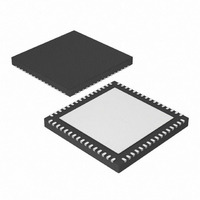PIC24FJ128GA106-E/MR Microchip Technology, PIC24FJ128GA106-E/MR Datasheet - Page 9

PIC24FJ128GA106-E/MR
Manufacturer Part Number
PIC24FJ128GA106-E/MR
Description
IC PIC MCU FLASH 128K 64-QFN
Manufacturer
Microchip Technology
Series
PIC® 24Fr
Datasheets
1.PIC24FJ128GA106-IPT.pdf
(14 pages)
2.PIC24FJ128GA106-IPT.pdf
(330 pages)
3.PIC24FJ128GA106-IPT.pdf
(52 pages)
4.PIC24FJ128GA110-EPT.pdf
(310 pages)
Specifications of PIC24FJ128GA106-E/MR
Program Memory Type
FLASH
Program Memory Size
128KB (43K x 24)
Package / Case
64-VFQFN, Exposed Pad
Core Processor
PIC
Core Size
16-Bit
Speed
32MHz
Connectivity
I²C, PMP, SPI, UART/USART
Peripherals
Brown-out Detect/Reset, POR, PWM, WDT
Number Of I /o
53
Ram Size
16K x 8
Voltage - Supply (vcc/vdd)
2 V ~ 3.6 V
Data Converters
A/D 16x10b
Oscillator Type
Internal
Operating Temperature
-40°C ~ 125°C
Processor Series
PIC24FJ
Core
PIC
Data Bus Width
16 bit
Data Ram Size
16 KB
Interface Type
I2C/SPI/UART
Maximum Clock Frequency
32 MHz
Number Of Programmable I/os
53
Number Of Timers
5
Maximum Operating Temperature
+ 125 C
Mounting Style
SMD/SMT
3rd Party Development Tools
52713-733, 52714-737, 53276-922, EWDSPIC
Development Tools By Supplier
PG164130, DV164035, DV244005, DV164005, PG164120, DM240001
Minimum Operating Temperature
- 40 C
On-chip Adc
16-ch x 10-bit
Lead Free Status / RoHS Status
Lead free / RoHS Compliant
Eeprom Size
-
Lead Free Status / Rohs Status
Lead free / RoHS Compliant
- PIC24FJ128GA106-IPT PDF datasheet
- PIC24FJ128GA106-IPT PDF datasheet #2
- PIC24FJ128GA106-IPT PDF datasheet #3
- PIC24FJ128GA110-EPT PDF datasheet #4
- Current page: 9 of 310
- Download datasheet (3Mb)
1.0
This document contains device-specific information for
the following devices:
This family expands on the existing line of Microchip‘s
16-bit general purpose microcontrollers, combining
enhanced
expanded and highly configurable peripheral feature
set. The PIC24FJ256GA110 family provides a new
platform for high-performance applications, which have
outgrown their 8-bit platforms, but don’t require the
power of a digital signal processor.
1.1
1.1.1
Central to all PIC24F devices is the 16-bit modified
Harvard architecture, first introduced with Microchip’s
dsPIC
offers a wide range of enhancements, such as:
• 16-bit data and 24-bit address paths with the
• Linear addressing of up to 12 Mbytes (program
• A 16-element working register array with built-in
• A 17 x 17 hardware multiplier with support for
• Hardware support for 32 by 16-bit division
• An instruction set that supports multiple
• Operational performance up to 16 MIPS
1.1.2
All of the devices in the PIC24FJ256GA110 family
incorporate a range of features that can significantly
reduce power consumption during operation. Key
items include:
• On-the-Fly Clock Switching: The device clock
2009 Microchip Technology Inc.
• PIC24FJ128GA106
• PIC24FJ192GA106
• PIC24FJ256GA106
• PIC24FJ128GA108
• PIC24FJ192GA108
• PIC24FJ256GA108
ability to move information between data and
memory spaces
space) and 64 Kbytes (data)
software stack support
integer math
addressing modes and is optimized for high-level
languages, such as ‘C’
can be changed under software control to the
Timer1 source or the internal, low-power RC
Oscillator during operation, allowing the user to
incorporate power-saving ideas into their software
designs.
®
digital signal controllers. The PIC24F CPU core
DEVICE OVERVIEW
Core Features
16-BIT ARCHITECTURE
POWER-SAVING TECHNOLOGY
computational
• PIC24FJ128GA110
• PIC24FJ192GA110
• PIC24FJ256GA110
performance
with
PIC24FJ256GA110 FAMILY
an
• Doze Mode Operation: When timing-sensitive
• Instruction-Based Power-Saving Modes: The
1.1.3
All of the devices in the PIC24FJ256GA110 family offer
five different oscillator options, allowing users a range
of choices in developing application hardware. These
include:
• Two Crystal modes using crystals or ceramic
• Two External Clock modes offering the option of a
• A Fast Internal Oscillator (FRC) with a nominal
• A Phase Lock Loop (PLL) frequency multiplier
• A separate internal RC Oscillator (LPRC) with a
The internal oscillator block also provides a stable
reference source for the Fail-Safe Clock Monitor. This
option constantly monitors the main clock source
against a reference signal provided by the internal
oscillator and enables the controller to switch to the
internal oscillator, allowing for continued low-speed
operation or a safe application shutdown.
1.1.4
Regardless of the memory size, all devices share the
same rich set of peripherals, allowing for a smooth
migration path as applications grow and evolve. The
consistent pinout scheme used throughout the entire
family also aids in migrating from one device to the next
larger, or even in jumping from 64-pin to 100-pin
devices.
The PIC24F family is pin-compatible with devices in the
dsPIC33 and PIC32 families, and shares some
compatibility with the pinout schema for PIC18 and
dsPIC30 devices. This extends the ability of applica-
tions to grow from the relatively simple, to the powerful
and complex, yet still selecting a Microchip device.
applications, such as serial communications,
require the uninterrupted operation of peripherals,
the CPU clock speed can be selectively reduced,
allowing incremental power savings without
missing a beat.
microcontroller can suspend all operations, or
selectively shut down its core while leaving its
peripherals active, with a single instruction in
software.
resonators.
divide-by-2 clock output.
8 MHz output, which can also be divided under
software control to provide clock speeds as low as
31 kHz.
available to the external oscillator modes and the
FRC Oscillator, which allows clock speeds of up
to 32 MHz.
fixed 31 kHz output, which provides a low-power
option for timing-insensitive applications.
OSCILLATOR OPTIONS AND
FEATURES
EASY MIGRATION
DS39905D-page 9
Related parts for PIC24FJ128GA106-E/MR
Image
Part Number
Description
Manufacturer
Datasheet
Request
R

Part Number:
Description:
General Purpose, 16-Bit Flash Microcontrollers
Manufacturer:
MICROCHIP [Microchip Technology]
Datasheet:

Part Number:
Description:
Manufacturer:
Microchip Technology Inc.
Datasheet:

Part Number:
Description:
Manufacturer:
Microchip Technology Inc.
Datasheet:

Part Number:
Description:
Manufacturer:
Microchip Technology Inc.
Datasheet:

Part Number:
Description:
Manufacturer:
Microchip Technology Inc.
Datasheet:

Part Number:
Description:
Manufacturer:
Microchip Technology Inc.
Datasheet:

Part Number:
Description:
Manufacturer:
Microchip Technology Inc.
Datasheet:

Part Number:
Description:
Manufacturer:
Microchip Technology Inc.
Datasheet:

Part Number:
Description:
Manufacturer:
Microchip Technology Inc.
Datasheet:










